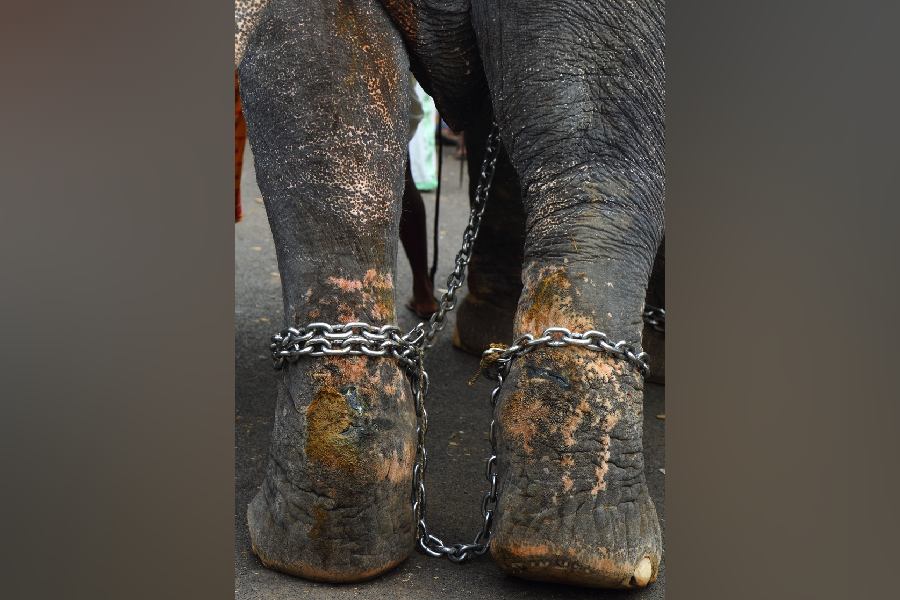|
|
Walking down Chitpur Road the other day, I was suddenly reminded of a couple of lines from one of Yeats’s poems. “Easter 1916”, I think it was — “All changed, changed utterly:/ A terrible beauty is born.” Around me, in that clear light of a summer morning, I saw an old part of the city changing, imperceptibly, but with a quiet assurance. The narrow road, the arrow-like tram line, old, ornate buildings, the printing presses, they were all there. So were the dawakhanas and jatra offices. But the main road and the serpentine lanes now also sprouted mobile outlets, a pretty card shop, even what looked like a swanky restaurant.
This irreversibility, I thought, was beautiful. It promised something new. Yet it was also terrible, for there were things — people, a culture, an economy, a kind of life — that were getting erased.
I was headed north. I passed tiny roadside temples, shops selling curious wares, an ageing, magnificent hospital façade, dirt, pans full of fried food. I was on a road that was full of its own smells — incense, white fume, sweat and that unmistakable stench of a life of fading grandeur and poverty. The sounds were somehow different as well: the tinkle of tram cars, temple bells, and the hum of a million voices talking together. It was so different, and refreshing, from the sanitized neutrality of a South Calcutta road.
I was beginning to sense why Chitpur Road has fascinated people of all sorts: researchers, academics, photographers, journalists from other parts of Calcutta as well as those from other cities. In their eyes, this stretch has always been a charming prism, a queer laboratory, to understand another time. Chitpur remains an anachronism, the proverbial Other.
But is old always beautiful? How does it feel, for instance, to live in Chitpur? To inhabit, and not intrude upon, a crumbling mansion on this narrow strip, hear the lurching vehicles, breathe the toxic air, and feel a whole, local economy and ways of life die around oneself? Despair and decay make moving images. But they surely leave a bitter aftertaste.
After some time, I reached a house on Brindaban Basak Street. From the outside, it looked disappointing — no more than an opaque, rectangular sprawl. As I climbed the rickety stairs, I began to sense how beautiful it was inside. An outer room led to a balcony that moved in a circle, connecting each room in a sweeping arch. I was there to meet the artist, Aditya Basak. I was hoping that he would answer some of the questions.
Basak took me to one of the small, quiet rooms. It belonged to his daughter, he told me later. There were a few paintings, a table, three chairs and a bed. The room, with its thick walls and red floor, looked simple, yet elegant. There was none of the clutter that one sees in a modern flat. In the course of our conversation, what started to unfold was a part of Chitpur’s story, but from the inside. The civic infrastructure, so crucial to the experience of living somewhere, was in a state of disrepair here, Basak said. The streets get waterlogged after a shower. The availability of water is unpredictable. Added to these are the problems of space, intermittent power supply, and the pressure of a burgeoning population. What Basak stressed though was the economic downturn in Chitpur. The once-flourishing markets, printing presses and theatre companies are struggling to survive. It is a familiar story of colonial opulence giving way to penury in a new world order, the story of an “utter change”.
Basak welcomed the nascent signs of the change that I saw earlier. The glistening kiosks and pretty, small shops. They are important signifiers of a new energy. He knows that Chitpur cannot remain unchanged, and that the people’s lives and survival are important. For that to happen, this sense of a stasis, and the beauty of a life so still, would have to go. But he is also conscious of the need to conserve such forms of beauty: the ancient mansions, alleys, and the life that they contain. He told me of his visit to China, and of his wonder and joy on witnessing the attempts at conservation there.
Basak loves Chitpur. He has spent his childhood here, and is not quite sure how it would feel to live in another part of Calcutta. (He has a studio in Salt Lake but prefers to work, and not stay, there.) He has many memories of Chitpur. The washing of the streets in the cool of dawn, conversations on para roks, horse carriages, and riotous festivals. When the lights go off late at night, he still loves watching the last tram-car approach, with the amber light from its carriage throwing strange patterns on the sidewalks. The tram disappears. The lights come back on again — but something is lost in that single, fleeting moment.











